Filter by
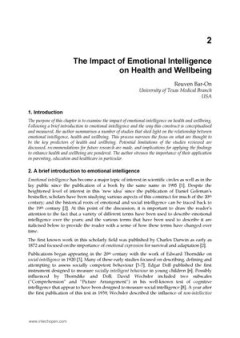
The Impact of Emotional Intelligence on Health and Wellbeing
The Impact of Emotional Intelligence on Health and Wellbeing
- Edition
- -
- ISBN/ISSN
- 9789533078380
- Collation
- -
- Series Title
- -
- Call Number
- -
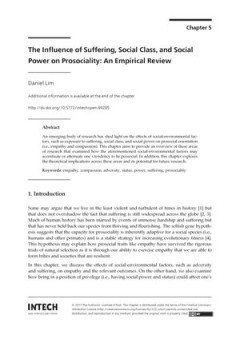
The influence of Suffering, Social Class, and Social Power On Prosociality A…
An emerging body of research has shed light on the effects of social‐environmental factors, such as exposure to suffering, social class, and social power on prosocial orientation (i.e., empathy and compassion). This chapter aims to provide an overview of these areas of research that examined how the aforementioned social‐environmental factors may accentuate or attenuate one’s tendency to …
- Edition
- -
- ISBN/ISSN
- 9789535134534
- Collation
- -
- Series Title
- -
- Call Number
- -
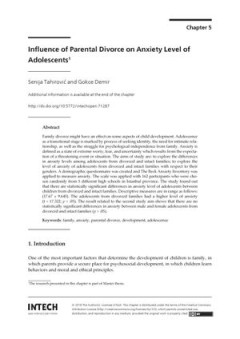
Influence of Parental Divorce on Anxiety Level of Adolescents
Family divorce might have an effect on some aspects of child development. Adolescence as a transitional stage is marked by process of seeking identity, the need for intimate relationship, as well as the struggle for psychological independence from family. Anxiety is defined as a state of extreme worry, fear, and uncertainty which results from the expectation of a threatening event or situation.…
- Edition
- -
- ISBN/ISSN
- 9789535137382
- Collation
- -
- Series Title
- -
- Call Number
- -
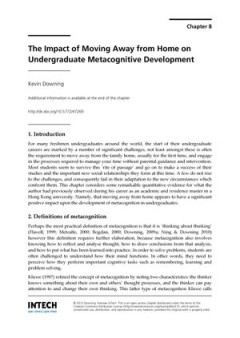
The Impact of Moving Away from Home on Undergraduate Metacognitive Development
The Impact of Moving Away from Home on Undergraduate Metacognitive Development
- Edition
- -
- ISBN/ISSN
- 9789535108559
- Collation
- -
- Series Title
- -
- Call Number
- -
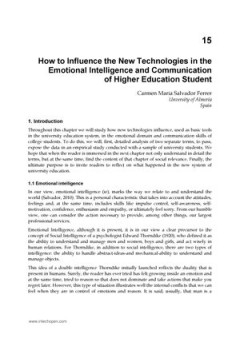
How to Influence the New Technologies in the Emotional Intelligence and Commu…
How to Influence the New Technologies in the Emotional Intelligence and Communication of Higher Education Student
- Edition
- -
- ISBN/ISSN
- 9789533078380
- Collation
- -
- Series Title
- -
- Call Number
- -
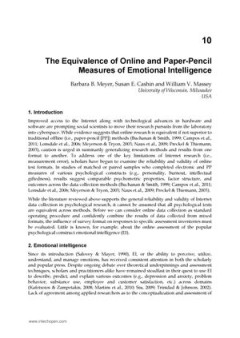
The Equivalence of Online and Paper-Pencil Measures of Emotional Intelligence
The Equivalence of Online and Paper-Pencil Measures of Emotional Intelligence
- Edition
- -
- ISBN/ISSN
- 9789533078380
- Collation
- -
- Series Title
- -
- Call Number
- -

Enhancing Young Children’s Access to Early Childhood Education and Care in …
This chapter draws on the current situation of limited access of young children to early childhood education and care (ECEC) settings in Tanzania. It offers information and evidence on early childhood education and care (ECEC) from an international perspective to those who are, directly or indirectly, involved with young children and their families. Basically, early childhood education and care…
- Edition
- -
- ISBN/ISSN
- 9789535137382
- Collation
- -
- Series Title
- -
- Call Number
- -
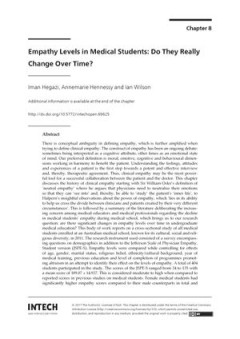
Empathy Levels in Medical Students Do They Really Change Over Time?
There is conceptual ambiguity in defining empathy, which is further amplified when trying to define clinical empathy. The construct of empathy has been an ongoing debate: sometimes being interpreted as a cognitive attribute, other times as an emotional state of mind. Our preferred definition is moral, emotive, cognitive and behavioural dimensions working in harmony to benefit the patient. Under…
- Edition
- -
- ISBN/ISSN
- 9789535134534
- Collation
- -
- Series Title
- -
- Call Number
- -
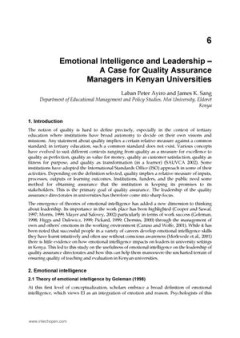
Emotional Intelligence and Leadership – A Case for Quality Assurance Manage…
Emotional Intelligence and Leadership – A Case for Quality Assurance Managers in Kenyan Universities
- Edition
- -
- ISBN/ISSN
- 9789533078380
- Collation
- -
- Series Title
- -
- Call Number
- -

Emotional intelligence The Most Potent Factor of Job Performance Among Execu…
Emotional Intelligence: The Most Potent Factor of Job Performance Among Executives
- Edition
- -
- ISBN/ISSN
- 9789533078380
- Collation
- -
- Series Title
- -
- Call Number
- -
 Computer Science, Information & General Works
Computer Science, Information & General Works  Philosophy & Psychology
Philosophy & Psychology  Religion
Religion  Social Sciences
Social Sciences  Language
Language  Pure Science
Pure Science  Applied Sciences
Applied Sciences  Art & Recreation
Art & Recreation  Literature
Literature  History & Geography
History & Geography